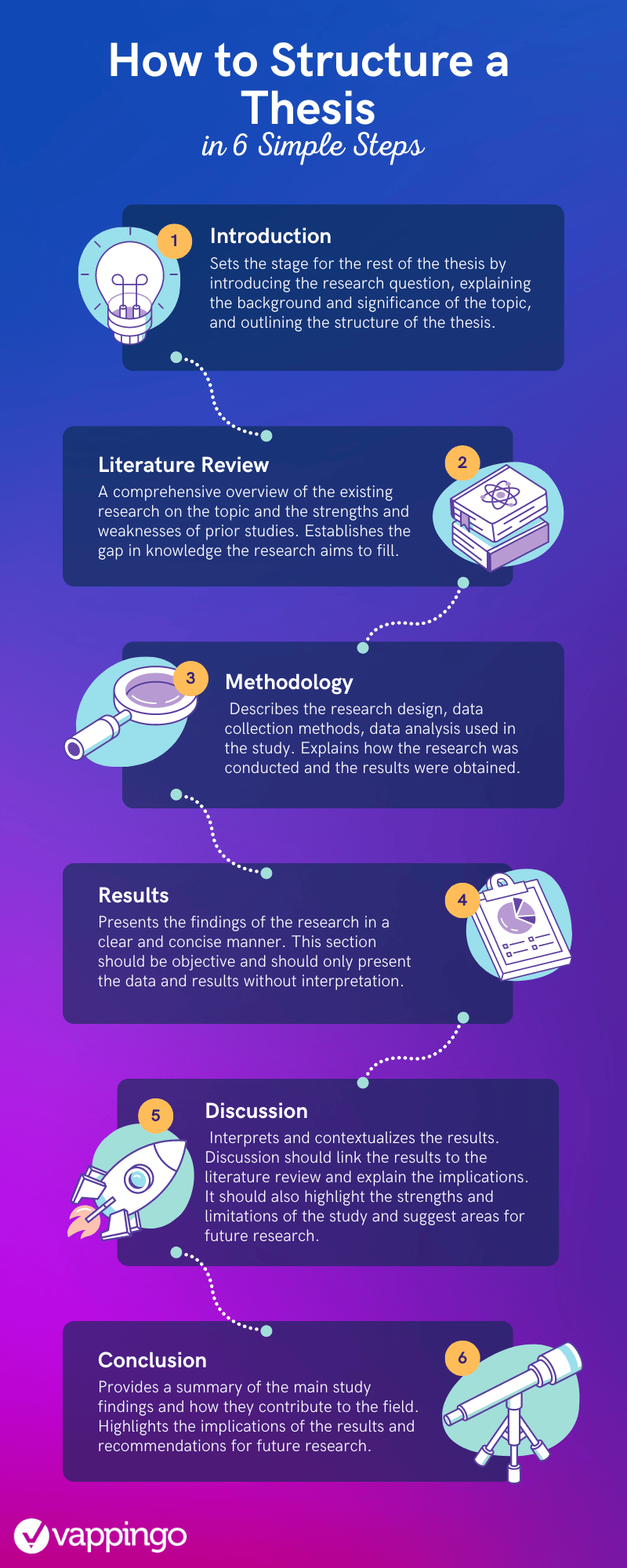Your 101 guide to the thesis structure.
Are you neck-deep in your thesis research?
Don’t know where to start when it comes to putting all your research findings and insights together within the final thesis?
Don’t panic.
Getting the structure of your thesis just right can make all the difference in the world. A well-structured thesis will help your ideas flow smoothly, ensure each chapter builds on the thesis statement, and bring everything together like a beautiful symphony.

In this article, we’ll break down the different elements that make up a solid thesis structure and give you some tips to help put it all together.
How to Structure Your Thesis
Before we go any further, it’s important that you understand that there is no ideal thesis structure. The requirements can differ from discipline to discipline. Furthermore, while some institutions will require you to format your work according to APA rules, others will expect you to follow in-house specifications.
As such, you should always check the expectations regarding the thesis structure with your professor or faculty representative.
In this article, we’ll present an overview of the typical thesis structure.
General Thesis Structure
The majority of theses will contain the following sections:
- Introduction
- Literature review
- Methodology
- Results
- Discussion
- Conclusion
Regardless of how you choose to structure or format your work, don’t underestimate the importance of proofreading your thesis before it is submitted. If you think you would benefit from assistance with this, check out our guide to finding the best dissertation proofreading service.

Introduction
The introduction to your thesis sets the tone for the rest of the work. An effective thesis or essay introduction should provide an overview of the purpose, scope, and methodology of the research, outline the thesis statement that guides the study, and provide some context for the reader. The following sections should be included in your introduction.
- Background Information: A brief overview of the topic you are researching and why it is important. This should include background to the history of the subject, the current state of research, and any gaps in knowledge that your work aims to fill.
- Problem or Thesis Statement: Clearly state the problem you are trying to solve or the research question you are trying to answer. This should be concise, specific and well-defined. See our guide to the thesis statement formula for more help. When you’ve written your thesis statement take a long hard look at it and ask yourself: Is this a thesis statement?
- Research Aims and Objectives: State the specific aims and objectives that will guide your research. Explain what you hope to achieve and how your research you will contribute to the field of study.
- Scope and Limitations: Define the scope of your study; i.e., What will it cover? What will not be included in the scope? This section of your overall thesis structure should also outline any limitations or assumptions that impact your work or the validity of the findings.
- Methodology: Provide an overview of the methods you will use to collect and analyze data, including the research design, sampling method, data collection instruments, and data analysis approach. Check out our guide to how to write a methodology for more help.
- Significance: Explain why your research is important and what impact it will have on your field of interest. For instance, how will the findings contribute to theory, practice, or policy?
- Outline: Provide an outline of the structure of the rest of your thesis, so the reader knows what to expect.
Literature Review
The literature review provides the reader with insights into the existing studies that have been performed in your area of interest. It demonstrates your understanding of the field and shares details of how you hope your study will add to existing knowledge. Consider including the following in your overall thesis structure:
- Topic overview: Include a brief history of the topic, the research that has already been performed, and the main theories, concepts, and frameworks of relevance to your topic.
- Previous research: Discuss the key findings, methodology, and limitations of the studies that have already been published. In addition to presenting the details of the existing research, you will also need to present your own analysis of the findings and identify any gaps or limitations that your research aims to address.
- Theoretical framework: Explain the theoretical framework or concept that underlies your research. Include the details of any relevant theories or models that will guide your own study.
- Research questions and hypotheses: Clearly state the research questions or hypotheses your study will address and how they relate to the existing research.
Methodology
The methodology section of your thesis outlines the research design, data collection methods, and analysis techniques used in the study. It provides a roadmap for the study and the steps that you took to make sure the results are reliable and valid. Here are some key elements that are typically found in the methodology section of a thesis.
- Research design: The type of research design used in your study, including the research philosophy, approach, and design.
- Data collection methods: The methods used to collect data, include the type of data (e.g., qualitative, quantitative), the data sources, and the sampling methods.
- Participants: The participants in your study, including the sample size, demographic information, and any relevant characteristics.
- Instruments and materials: The tools you used to collect data, such as questionnaires, surveys, or interviews. This section will also contain details of how you developed and validated your research tools.
- Data analysis methods: The specific processes you followed to analyze the data, including the statistical techniques and software used.
- Ethical considerations: Any ethical considerations you took into account during the study. For instance, informed consent, confidentiality, and data protection.
Results
This is where you present the findings of your research and share details of your evidence. Some of the information you may wish to share in this section of your thesis structure is as follows:
- Data and findings: Present your data and findings in an organized and concise manner. Use infographics, charts, graphs, figures, and tables to help the reader understand your findings.
- Statistical analysis: Present the results of any statistical analysis you performed, including the means, standard deviations, and any significance tests performed.
- Interpretation of results: Help the reader understand what the results mean in practice and why they may be significant.
Discussion
The discussion section of the thesis structure is where you tie everything together. Here, you present your interpretations of your results. The discussion presents you with an opportunity to connect your results back to the research questions or hypotheses that you presented in your introduction. Here are some important elements that should be included in your discussion section:
- Summary of findings: Provide a concise summary of your main findings, including any statistical results, key trends, or patterns in the data.
- Interpretation of results: Interpret the results of the study. Explaining what the findings mean and why they are important in your field of interest.
- Comparison of your findings with the previous research: Highlighting areas of agreement and disagreement, and explaining any unexpected results.
- Implications: Discuss the practical implications of your findings.
- Limitations: Discuss any limitations of your study. Explain how these limitations may have impacted the final results.
- Future research directions: Including your recommendations for future research. Focus on how future studies can fill the remaining gaps and address any limitations you identified.
Conclusion
The conclusion section of a thesis is where you tie everything together and summarize the main findings and implications of your research. It’s the final word on the topic and the place to make a lasting impression on the reader. Here are some key elements that should be included in your conclusion section:
- Summary of findings: Summarize the main findings of your study, including any notable trends or patterns in the data.
- Interpretation of results: Interpret the results of your study, explaining what the findings mean and why they are important.
- Implications for practice: Discuss the practical implications of your findings. Make sure you include recommendations for future research or practice in the field.
- Limitations: Discuss any limitations of the study, including limitations in the research design, data collection methods, or data analysis techniques, and explain how they may have impacted your results.
- Future research: Discuss potential avenues for future research. Refer back to the findings and limitations of your current study.
- Final thoughts: Provide a final perspective on the research, including any personal reflections or insights gained through the process.
Additional Sections in Your Thesis Structure
Your thesis structure will also include a references section in which you list all the sources you cited in the thesis, including books, journal articles, and other sources. The format of the references section may vary depending on the discipline and the citation style used. For instance, you may be required to follow APA formatting or an MLA style guide.
In addition to these main sections, some theses may also include an abstract, appendices, tables, figures, and graphs.
Regardless of how you structure your thesis, the key to success is to define a clear thesis statement and present your study and research findings in a clear, concise, and well-organized manner.


6 thoughts on “Thesis Structure: How to Effectively Present Your Research”